|

by Michael Bara
1996
from
LunarAnomalies Website
This mosaic of Clementine UVVIS images (below) covers the center of
the impact crater Tycho. It was formed when a large meteorite (or
comet) slammed into the Moon. The version on the right is a 3 color
composite (415 nm, 750 nm, 1000 nm); the version in the center is a
color composite of wavelength ratios which show different rock and
soil types. Note the distinct color difference of the central peak
due to excavation of deep material during the impact that formed the
crater.
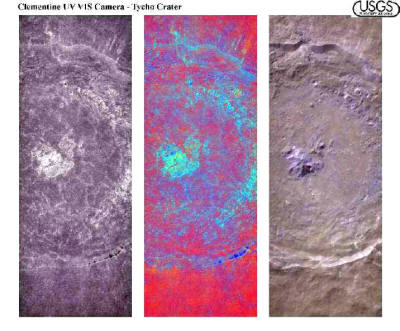
The ratio image on the left enhances an
unusual polygonal pattern in the floor of the crater. The origin of
this feature is not clear, however future work using all 11
wavelengths collected by the UVVIS and NIR cameras will most likely
reveal the origin of these enigmatic "cracks".
These below Clementine Images and the accompanying caption were
found on the USGS Clementine web site. They show not only the
anomalous "polygonal pattern", but some highly unusual "debris" on
the terraced ridge overlooking the crater floor.
The right hand 3-color mosaic (above) shows 5 of
the brightest objects certainly do not resemble "standard" Lunar
debris.
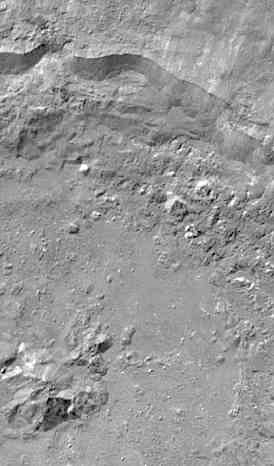
The first image above shows Tycho crater
(43S, 12W) from the UV/Vis camera with the 1000 nm filter. The image
was taken on Orbit 40 on 28 Feb 1994,13:17:00 UT at an altitude of
425 Km. North is upward in this image.
This "regular" (visible light) Clementine image was taken from the NSSDC Clementine section on their web page and tends to hide the
"polygonal pattern" but shows the "Lunar Village" in sharp relief.
The polygonal pattern may be indicative of a "substructure" beneath
the crater floor.
It has been implied that the Moon itself may be either constructed
or at least partially modified. There is actually some reason to
consider this idea. It has been noted that all craters on the Moon
seem to have about the same depth, irrespective of the size (and
mass) of the impacting object.
Also, the Moon seems to be "light". It
does not have the proper density for its apparent make-up. (I will
dig up sources on these observations when time permits). Tycho does
seem to be insufficiently deep given its width. The "polygonal
pattern" resembles a skin stretched over a gridwork.
As for the debris, a close up of some of the objects shows just how
unusual they are.
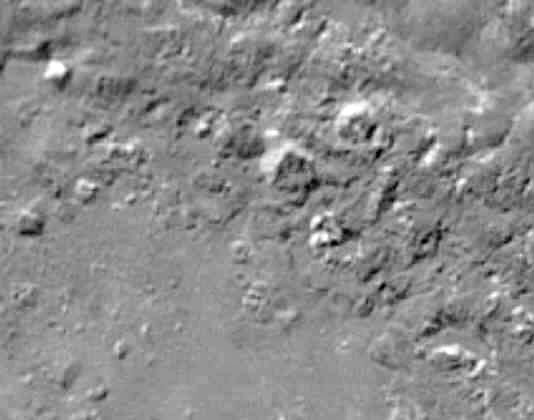
For comparison purposes, I have labeled
these objects the "Pyramid", the "Chalet", "Geodome", the "Longhorn"
and the "Backhoe". This does not mean that I am suggesting that
these are in fact a backhoe, chalets, or a true pyramid.
However, all these objects stand out
based on their brightness relative to the surrounding terrain, their
unusual geometric shapes, and their proximity to each other.
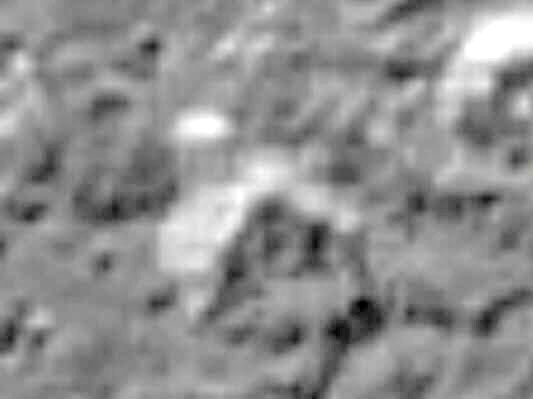
The "Chalet"
This object I've dubbed the "Chalet",
looks somewhat like an A-frame building. Note that it appears to
form fit on the left hand side matching the terraced terrain. It is
also far brighter than the surrounding ground, indicating it is made
of a different material.
The "roof" seems to overhang the flat
faced supporting structure, and dark "windows" are visible in a
pattern on the front face.
The "chimney" has several dark vertical
striations, hinting at some sort of venting system. They are almost
certainly not image artifacts, as they end where the "chimney" meets
the "roof". The "chimney" also has a domed tip with a flange.
The accompanying object, "Chalet 2" also displays comparable
peculiar characteristics.
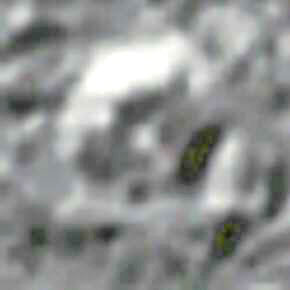
Roughly hexagonal in shape, it too seems
to jut from the hillside as if it were the tip of a much larger sub
surface object or was actually "dug in" to the side of the hill. It
as well has an apparent overhanging "roof" with an exposed flat face
front "wall" facing out to the crater. It also has "windows" similar
to the "chalet" and a possible entrance at the base. It is set apart
from the background by the brightness of the "roof" and its geodesic
shape, similar to late 1970's concepts of "solar" homes.
The "Pyramid"
Slightly northwest of the "chalet" is this enigmatic faceted
object. Again it is very bright and appears to have a 4 sided
pyramidal structure. The direction of the shadows makes
determining the details of the underside impossible, but the
object does appear to be generally symmetrical.
It also maintains its pyramidal
characteristics in both the color composite mosaic shown in the
USGS images.
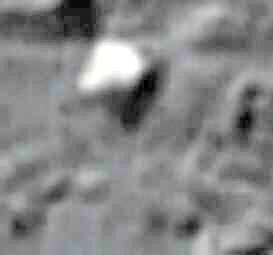
The "Backhoe"
This object resembles a tractor or bulldozer with a drooping
scoop set off to the right. It seems to have an opening
in-between the "arm" and the base of the main body. There are
cavities beneath the object in shadow, separated by a "post"
between them.
The "arm" seems to be made of as
many as 8 individual components. The shadow indicates this is a
solid vertical structure and its brightness against the
background imply it is not made of the same material.
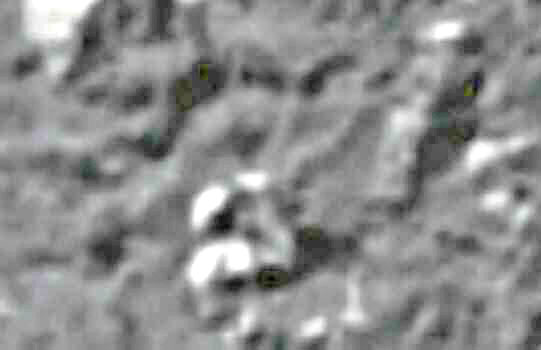
The "Longhorn"
This looks to be a basically symmetrical object with 2 central
"nodes" and curved arms extending from the central body. There
appears to be some underlying support just to the left of the
right hand curved "arm", but the central spherical "node" looks
to be above the ground, judging by the shadow beneath it.
Note that is also sits in what
resembles an excavated "pen" or platform, which is reasonably
rectilinear from this resolution. I am not aware of any accepted
process that could account for this object forming naturally.
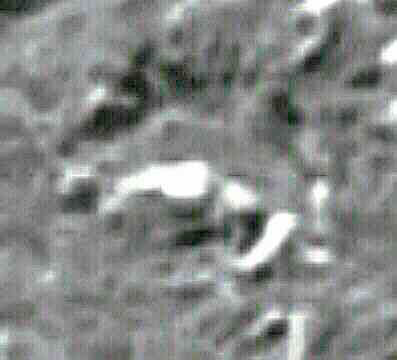
Summary
Each of these objects on their own could potentially be explained
away by some exotic natural process. However, due to their grouping
in such a small area and varying characteristics, it's unlikely one
explanation could encompass them all. These objects all have the
look of machinery or constructs, as opposed to the simple boulders
and cracks which should dominate this landscape. Indeed, the very
complexity of these objects argues for their non-natural origin.
A fractal analysis of this crater could
potentially validate their uniqueness against the backdrop. I will
also attempt to find high resolution images of the floor of Tycho
from other sources, as Clementines' data is rather coarse. As it
stands, none of these objects fits any geological model of the Moon
that I am aware of. For the moment, they must stand as truly
anomalous and potentially artificial.
|








